Development of Sliding Mode Controller for a Modified Boost Ćuk Converter Configuration
Abstract
:1. Introduction
2. High Output Gain Modified Ćuk Converter
3. Equivalent Control of Modified Ćuk Converter
4. Simulation Results
- 0.03–0.06 s: Output voltage reference is changed from −150 V to −50 V.
- 0.08–0.11 s: Load resistance is decreased from 100 Ω to 50 Ω (100% load increase)
- 0.13–0.16 s: Input voltage is decreased from 15 V to 12 V (20% input voltage dip)
- 0.18–0.21 s: Input inductor (L1) is decreased from 100 μH to 85 μH (15% L1 reduction)
- 0.03–0.06 s: Output voltage reference is changed from −145 V to −45 V.
- 0.08–0.11 s: Load resistance is decreased from 100 Ω to 85 Ω (15% load increase)
- 0.13–0.16 s: Input voltage is decreased from 15 V to 12 V (20% input voltage dip)
- 0.18–0.21 s: Input inductor (L1) is decreased from 100 μH to 85 μH (15% L1 reduction)
5. Conclusions
Acknowledgments
Author Contributions
Conflicts of Interest
References
- Sanjeevikumar, P.; Grandi, G.; Wheeler, P.; Blaabjerg, F.; Loncarski, J. A simple mPPT algorithm for novel PV power generation system by high output voltage DC-DC boost Converter. In Proceedings of the 24th International Symposium on Industrial Electronics, Rio de Janeiro, Brazil, 3–5 June 2015; pp. 214–220. [Google Scholar]
- Mahajan, S.B.; Sanjeevikumar, P.; Blaabjerg, F. A Multistage DC-DC step-up self-balanced and magnetic component-free converter for photovoltaic application: Hardware implementation. Energies 2017, 10, 719. [Google Scholar]
- Mahajan, S.B.; Sanjeevikumar, P.; Blaabjerg, F.; Ojo, S.; Seshagiri, S.; Kulkarni, R. Inverting Nx and 2Nx non isolated multilevel boost converter for renewable energy application. In Proceedings of the 4th IET International Conference on Clean Energy and Technology, Kuala Lumpur, Malaysia, 14–15 November 2016; pp. 1–8. [Google Scholar]
- Sanjeevikumar, P.; Grandi, G.; Blaabjerg, F.; Wheeler, P.; Siano, P.; Hammami, M. A Comprehensive Analysis and Hardware Implementation of Control Strategies for High Output Voltage DC-DC Boost Power Converter. Int. J. Comput. Intell. Syst. 2017, 10, 140–152. [Google Scholar]
- Mahajan, S.B.; Sanjeevikumar, P.; Wheeler, P.; Blaabjerg, F.; Rivera, M.; Kulkarni, R. XY converter family: A new breed of buck boost converter for high step-up renewable energy applications. In Proceedings of the IEEE International Conference on Automatica, Curico, Chile, 19–21 October 2016; pp. 1–8. [Google Scholar]
- Bhaskar, M.S.; Sanjeevikumar, P.; Kulkarni, R.; Blaabjerg, F.; Seshagiri, S.; Hajizadeh, A. Novel LY converter topologies for high gain transfer ratio—A new breed of XY family. In Proceedings of the 4th IET International Conference on Clean Energy and Technology, Kuala Lumpur, Malaysia, 14–15 November 2016; pp. 4–8. [Google Scholar]
- Mahajan, S.B.; Kulkarni, R.; Sanjeevikumar, P.; Blaabjerg, F.; Fedák, V.; Cernat, M. Non-isolated and non-inverting Cockcroft Walton multiplier based hybrid 2Nx interleaved boost converter for renewable energy applications. In Proceedings of the IEEE Conference on 17th The Power Electronics and Motion Control, Varna, Bulgaria, 25–28 September 2016; pp. 146–151. [Google Scholar]
- Mahajan, S.B.; Kulkarni, R.; Sanjeevikumar, P.; Siano, P.; Blaabjerg, F. Hybrid Non-isolated and non-inverting Nx interleaved DC-DC multilevel boost converter for renewable energy applications. In Proceedings of the 16th IEEE International Conference on Environment and Electrical Engineering, Florence, Italy, 7–10 June 2016; pp. 1–6. [Google Scholar]
- Sanjeevikumar, P.; Kabalci, E.; Iqbal, A.; Abu-Rub, H.; Ojo, O. Control strategy and hardware implementation for DC-DC boost power conversion based on proportional-integral compensator for high voltage application. Eng. Sci. Tech. Int. J. 2014, 18, 163–170. [Google Scholar]
- Li, C.W.; He, X. Review of non-isolated high step-up DC/DC converters in photovoltaic grid-connected applications. IEEE Trans. Ind. Electron. 2011, 58, 1239–1250. [Google Scholar] [CrossRef]
- Costantino, N.; Serventi, R.; Tinfena, F.; D’Abramo, P.; Chassard, P.; Tisserand, P.; Fanucci, L. Design and test of an HV-CMOS intelligent power switch with integrated protections and self-diagnostic for harsh automotive applications. IEEE Trans. Ind. Electron. 2011, 58, 2715–2727. [Google Scholar] [CrossRef]
- Saponara, S.; Pasetti, G.; Tinfena, F.; Fanucci, L.; D’Abramo, P. HV-CMOS design and characterization of a smart rotor coil driver for automotive alternators. IEEE Trans. Ind. Electron. 2013, 60, 2309–2317. [Google Scholar] [CrossRef]
- Baronti, F.; Lazzeri, A.; Roncella, R.; Saletti, R.; Saponara, S. Design and characterization of a robotized gearbox system based on voice coil actuators for a Formula SAE Race Car. IEEE/ASME Trans. Mechatron. 2013, 18, 53–61. [Google Scholar] [CrossRef]
- Saponara, S.; Fanucci, L.; Bernardo, F.; Falciani, A. Predictive diagnosis of high-power transformer faults by networking vibration measuring nodes with integrated signal processing. IEEE Trans. Inst. Meas. 2016, 65, 1749–1760. [Google Scholar] [CrossRef]
- Zhu, M.; Luo, F.L. Enhanced self-lift Ćuk converter for negative to positive voltage conversion. IEEE Trans. Power Electron. 2010, 25, 2227–2233. [Google Scholar] [CrossRef]
- Sabzali, A.J.; Ismail, E.H.; Al-Saffar, M.A.; Fardoun, A.A. New bridgeless DCM Sepic and Ćuk PFC rectifiers with low conduction and switching losses. IEEE Trans. Ind. Appl. 2011, 47, 873–881. [Google Scholar] [CrossRef]
- Ćuk, S.; Middlebrook, R.D. Advances in switched-mode power conversion part I. IEEE Trans. Ind. Electron. 1983, 1, 10–19. [Google Scholar] [CrossRef]
- Ćuk, S.; Middlebrook, R.D. Advances in switched-mode power conversion part II. IEEE Trans. Ind. Electron. 1983, 1, 19–29. [Google Scholar] [CrossRef]
- Rashid, M.H. Power Electronics Handbook: Circuits, Devices and Applications; Elsevier: New York, NY, USA, 2010; pp. 249–265. [Google Scholar]
- Flores, J.L.; Avalos, J.; Espinoza, C.A.B. Passivity-based controller and online algebraic estimation of the load parameter of the DC-to-DC power converter Ćuk type. IEEE Lat. Am. Trans. 2011, 9, 50–57. [Google Scholar] [CrossRef]
- Mahdavi, J.; Nasiri, M.R.; Agah, A.; Emadi, A. Application of neural networks and state-space averaging to DC/DC PWM converters in sliding mode operation. IEEE/ASME Trans. Mechatron. 2005, 10, 60–67. [Google Scholar] [CrossRef]
- Safari, A.; Mekhilef, S. Simulation and hardware implementation of incremental conductance MPPT with direct control method using Ćuk converter. IEEE Trans. Ind. Electron. 2011, 58, 1154–1161. [Google Scholar] [CrossRef]
- Balestrino, A.; Landi, A.; Sani, L. Ćuk converter global control via fuzzy logic and scaling factors. IEEE Trans. Ind. Appl. 2002, 38, 406–413. [Google Scholar] [CrossRef]
- Chen, Z. PI and sliding mode control of a Ćuk converter. IEEE Trans. Power Electron. 2012, 27, 3695–3703. [Google Scholar] [CrossRef]
- Utkin, V.; Guldner, J.; Jingxin, S. Sliding Mode Control in Electro-Mechanical Systems; CRC Press: Boca Raton, USA, 2009; pp. 325–355. [Google Scholar]
- Venkataramanan, R.; Sabanovic, A.; Ćuk, S. Sliding mode control of DC–DC converters. In Proceedings of the 2012 IEEE 51st Annual Conference on Decision and Control, Maui, HI, USA, 10–13 December 2012. [Google Scholar]
- Venkataramanan, R. Sliding Mode Control of Power Converters. Ph.D. Thesis, California Institute of Technology, Pasadena, CA, USA, 1986. [Google Scholar]
- Tan, S.C.; Lai, Y.M.; Chi, K.T. General design issues of sliding-mode controllers in DC-DC converters. IEEE Trans. Power Electron. 2008, 55, 1160–1174. [Google Scholar]
- Ahmad, F.; Rasool, A.; Ozsoy, E.E.; Sabanovic, A.; Elitas, M. A robust cascaded controller for DC-DC boost and Ćuk converters. World J. Eng. 2017, 14. [Google Scholar] [CrossRef]
- Ahmad, F.; Rasool, A.; Ozsoy, E.E.; Sabanovic, A.; Elitas, M. Design of a robust cascaded controller for Cuk converter. In Proceedings of the IEEE International Power Electronics and Motion Control Conference, Varna, Bulgaria, 25–28 September 2016; pp. 80–85. [Google Scholar]
- Cardoso, B.J.; Moreira, A.F.; Menezes, B.R.; Cortizo, P.C. Analysis of switching frequency reduction methods applied to sliding mode controlled DC-DC converters. In Proceedings of the 7th Annual Applied Power Electronics Conference and Exposition, Boston, MA, USA, 23–27 February 1992; pp. 403–410. [Google Scholar]
- He, Y.; Luo, F.L. Sliding-mode control for dc–dc converters with constant switching frequency. IEEE Proc. Control Theory Appl. 2006, 153, 37–45. [Google Scholar] [CrossRef]
- Agostinelli, M.; Priewasser, R.; Marsili, S.; Huemer, M. Constant switching frequency techniques for sliding mode control in DC-DC converters. In Proceedings of the 2011 Joint 3rd Int’l Workshop on Nonlinear Dynamics and Synchronization (INDS) & 16th Int’l Symposium on Theoretical Electrical Engineering (ISTET), Klagenfurt, Austria, 25–27 July 2011; pp. 1–5. [Google Scholar]
- Tan, S.C.; Lai, Y.M.; Tse, C.K.; Cheung, M.K. A fixed-frequency pulse width modulation based quasi-sliding-mode controller for buck converters. IEEE Trans. Power Electron. 2005, 20, 1379–1392. [Google Scholar] [CrossRef]
- Leung, K.K.S.; Chung, H.S.H. Dynamic hysteresis band control of the buck converter with fast transient response. IEEE Trans. Circuits Syst. II Expr. Briefs 2015, 52, 398–402. [Google Scholar] [CrossRef]
- Ho, C.N.M.; Cheung, V.S.; Chung, H.S.H. Constant-frequency hysteresis current control of grid-connected VSI without bandwidth control. IEEE Trans. Power Electron. 2009, 24, 2484–2495. [Google Scholar] [CrossRef]
- Park, S.H.; Park, S.R.; Yu, J.S.; Jung, Y.C.; Won, C.Y. Analysis and design of a soft-switching boost converter with an HI-Bridge auxiliary resonant circuit. IEEE Trans. Power Electron. 2010, 25, 2142–2149. [Google Scholar] [CrossRef]


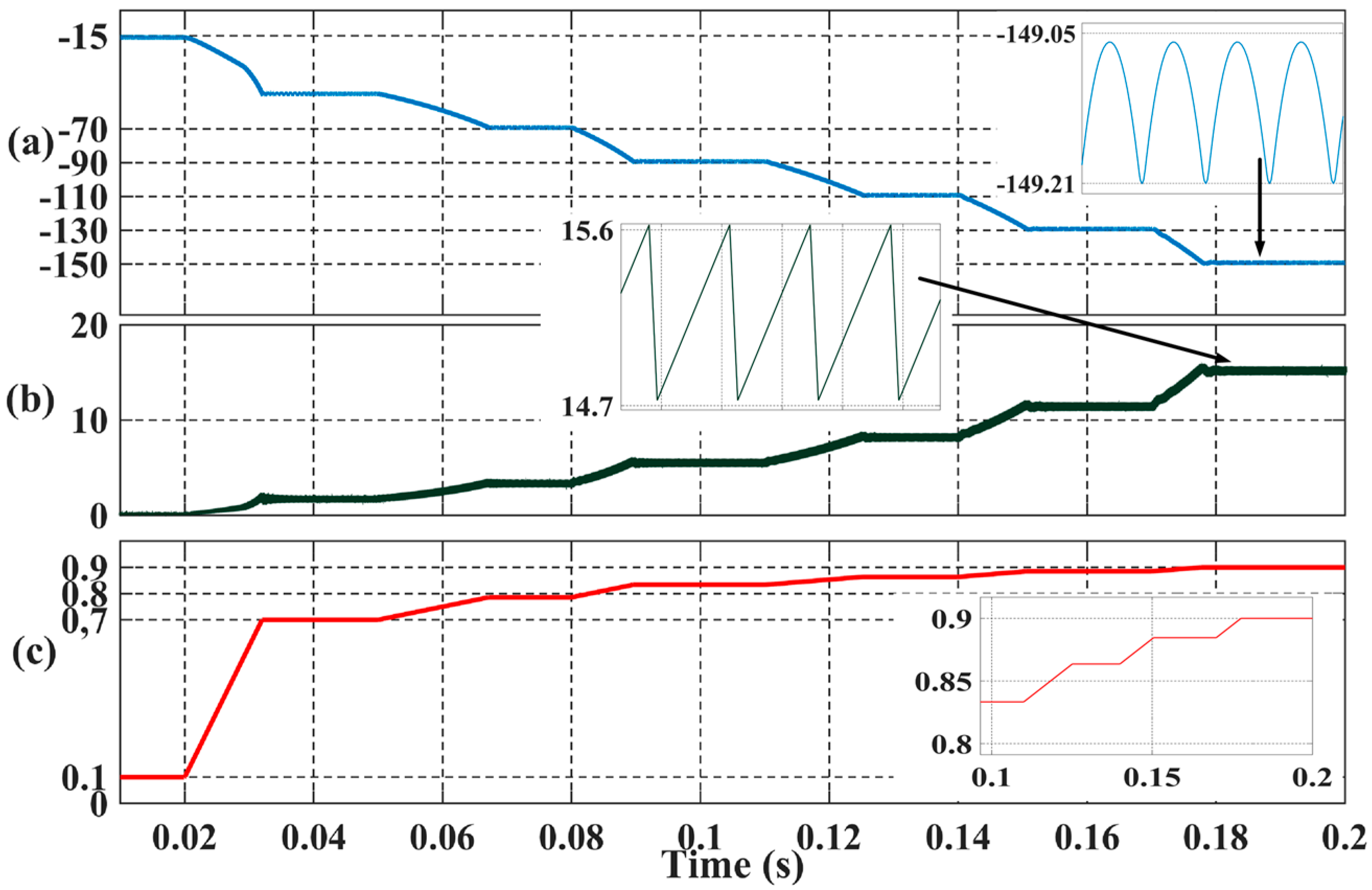

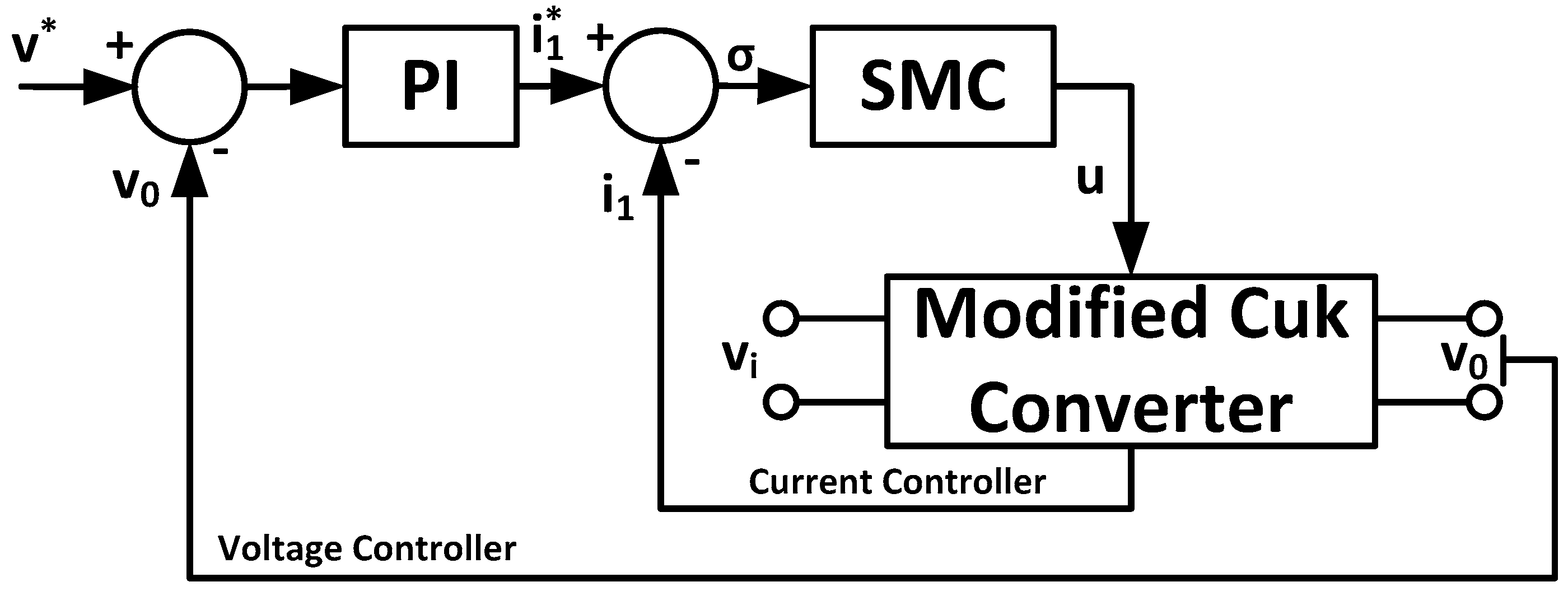



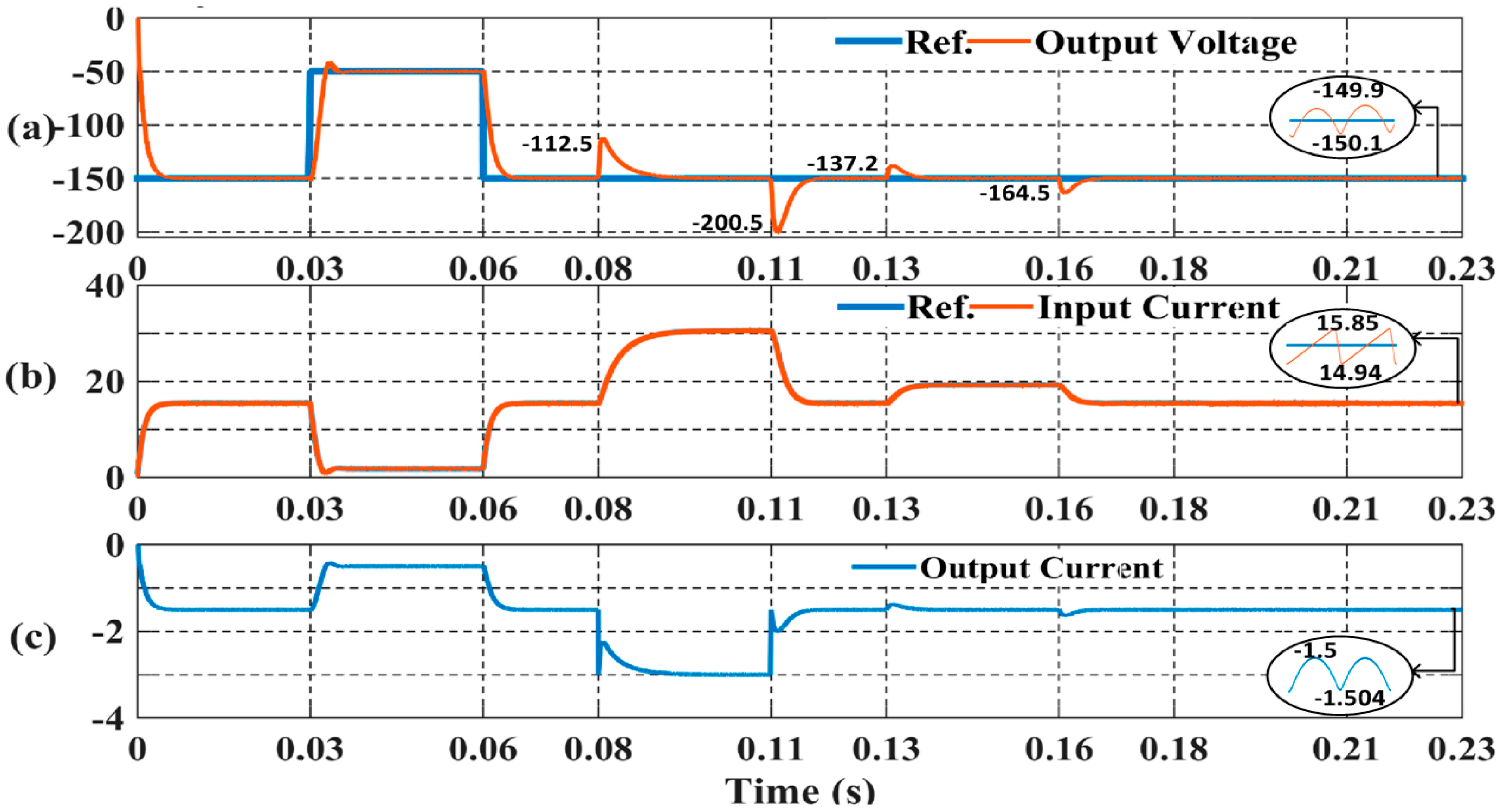

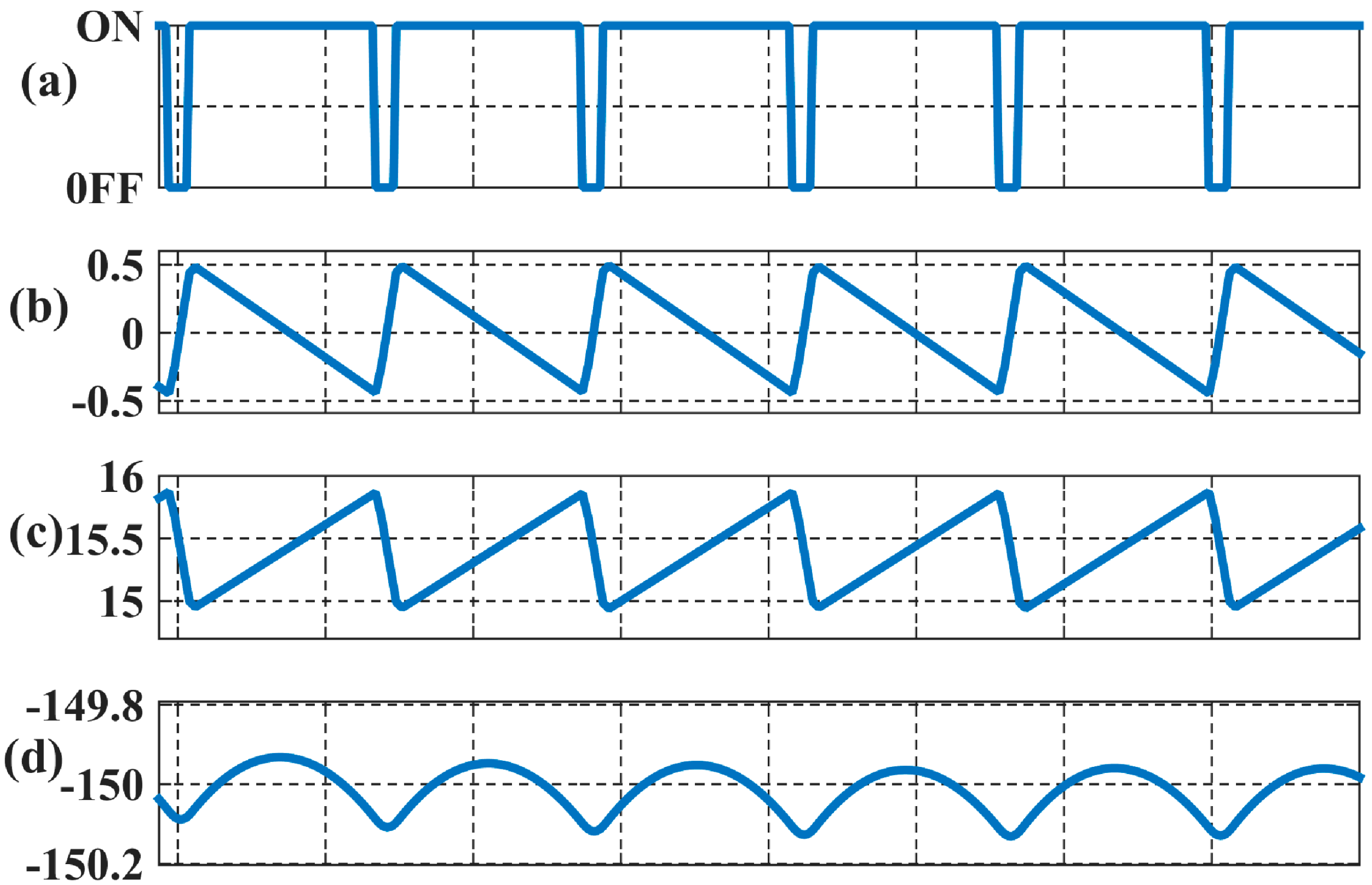
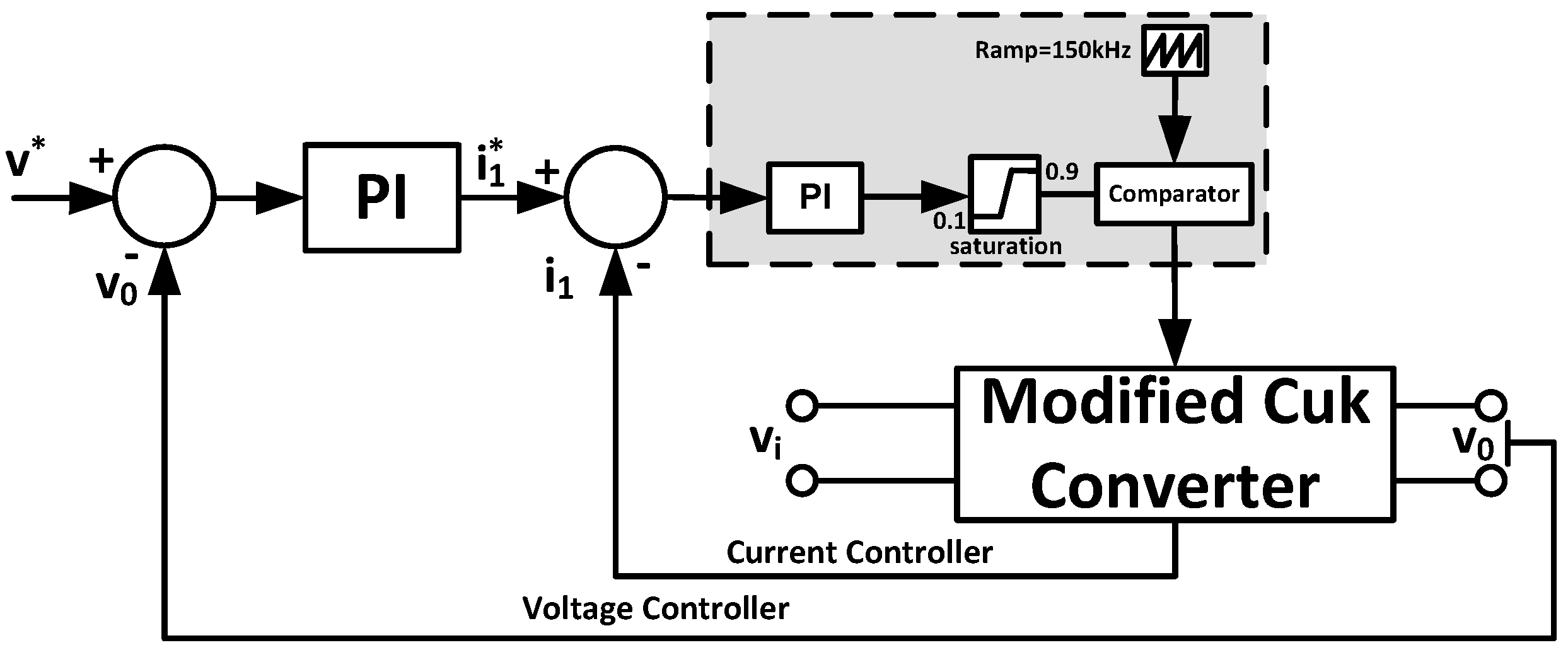
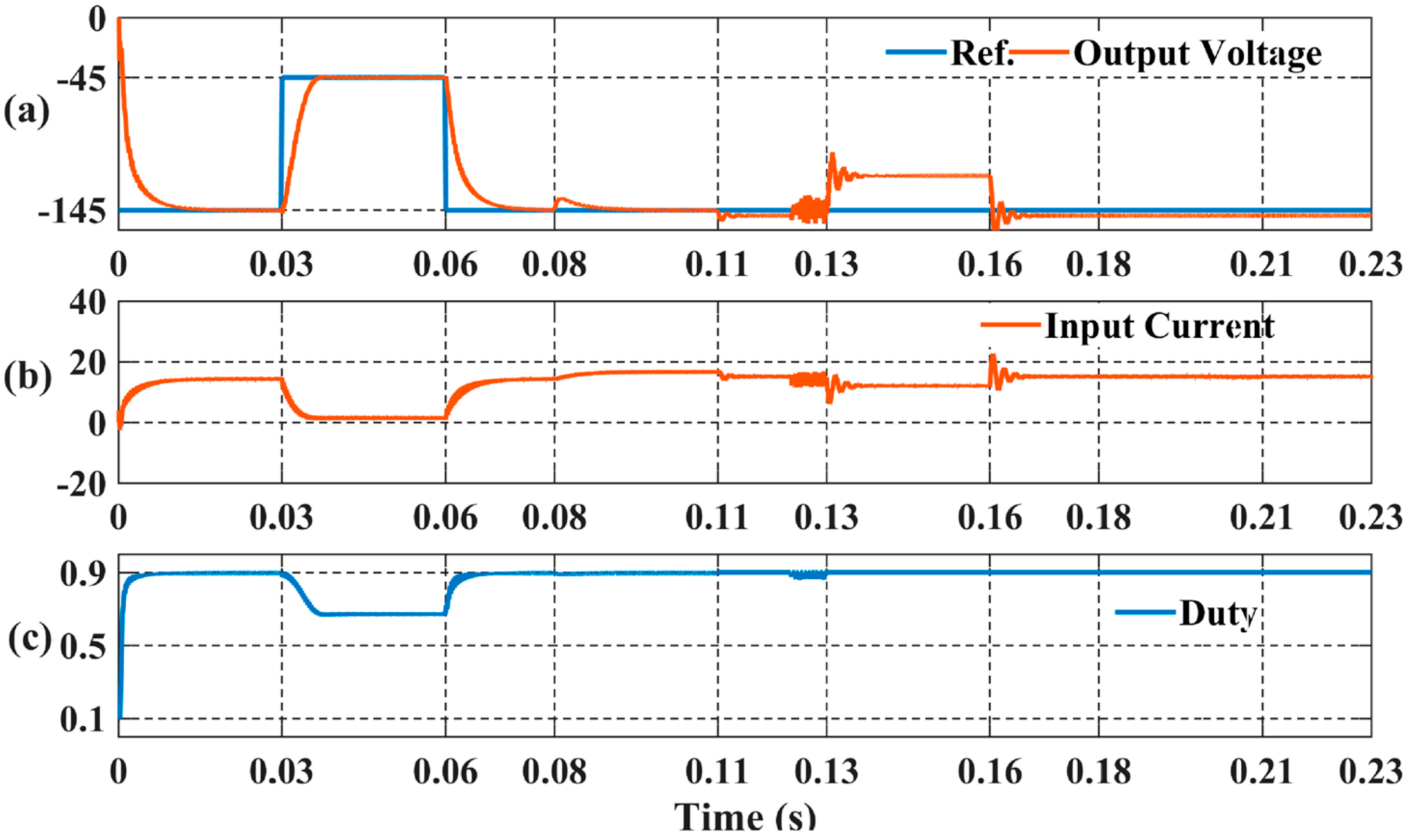
| Symbol | Quantity | Unit |
|---|---|---|
| Input Voltage | 15 | V |
| Duty Ratio (∆) | 0.1–0.9 | – |
| Switching Frequency | 150 | kHz |
| Inductances (L1, L2, L3) | 100 | μH |
| Capacitors (C0, C1, C2) | 5 | μF |
| Load Resistance | 100 | Ω |
| Symbol | Quantity |
|---|---|
| Kp of voltage PI controller | 0.001 |
| KI of PI voltage controller | 90 |
| Target switching frequency | 140–160 kHz |
| K of equivalent controller | 0.01 |
| L of equivalent controller | 1 |
| Kp of hysteresis controller | 0.00005 |
| KI of hysteresis controller | 0.6 |
| Symbol | Quantity |
|---|---|
| Kp of PI voltage controller | 0.001 |
| KI of PI voltage controller | 50 |
| Kp of PI current controller | 0.001 |
| KI of PI current controller | 500 |
| Switching Frequency | 150 kHz |
| Perturbation | Vo Peak Overshoot | M | ii Ripple (A) | Vo Ripple (V) |
|---|---|---|---|---|
| Steady State (No Perturbation) | N/A | 0.3750 | 0.9 | 0.15 |
| 0.03 s: Vo −150 to −50 V | 5.2 V | 0.3476 | 0.7 | 0.14 |
| 0.06 s: Vo −150 to −50 V | 0 | |||
| 0.08 s: RL 100 to 50 Ω | 37.5 V | 0.3748 | 0.9 | 0.17 |
| 0.11 s: RL 50 to 100 Ω | 50.5 V | |||
| 0.13 s: Vi 15 to 12 V | 12.8 V | 0.297 | 0.6 | 0.12 |
| 0.16 s: Vi 12 to 15 V | 14.5 V | |||
| 0.18 s: L1 100 to 85 μH | 0 | 0.435 | 1.8 | 0.16 |
| 0.21 s: L1 85 to 100 μH | 0 |
© 2017 by the authors. Licensee MDPI, Basel, Switzerland. This article is an open access article distributed under the terms and conditions of the Creative Commons Attribution (CC BY) license (http://creativecommons.org/licenses/by/4.0/).
Share and Cite
Padmanaban, S.; Ozsoy, E.; Fedák, V.; Blaabjerg, F. Development of Sliding Mode Controller for a Modified Boost Ćuk Converter Configuration. Energies 2017, 10, 1513. https://doi.org/10.3390/en10101513
Padmanaban S, Ozsoy E, Fedák V, Blaabjerg F. Development of Sliding Mode Controller for a Modified Boost Ćuk Converter Configuration. Energies. 2017; 10(10):1513. https://doi.org/10.3390/en10101513
Chicago/Turabian StylePadmanaban, Sanjeevikumar, Emre Ozsoy, Viliam Fedák, and Frede Blaabjerg. 2017. "Development of Sliding Mode Controller for a Modified Boost Ćuk Converter Configuration" Energies 10, no. 10: 1513. https://doi.org/10.3390/en10101513






